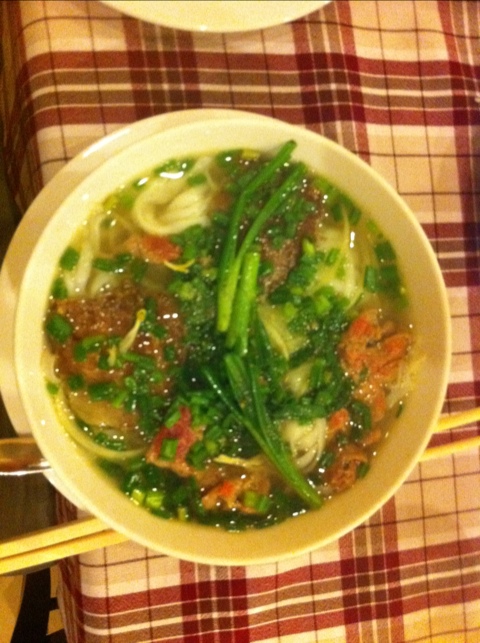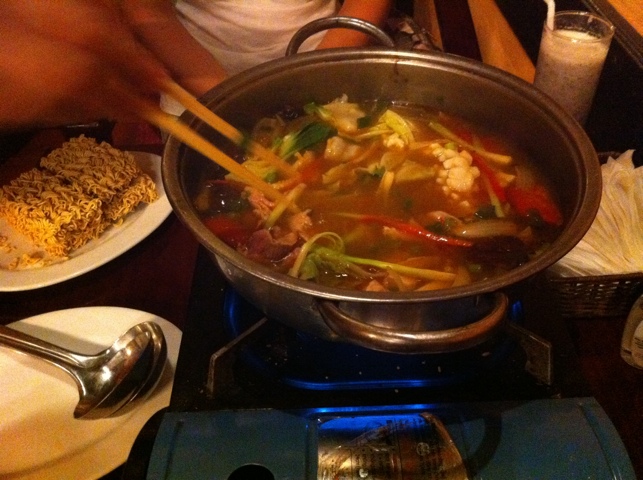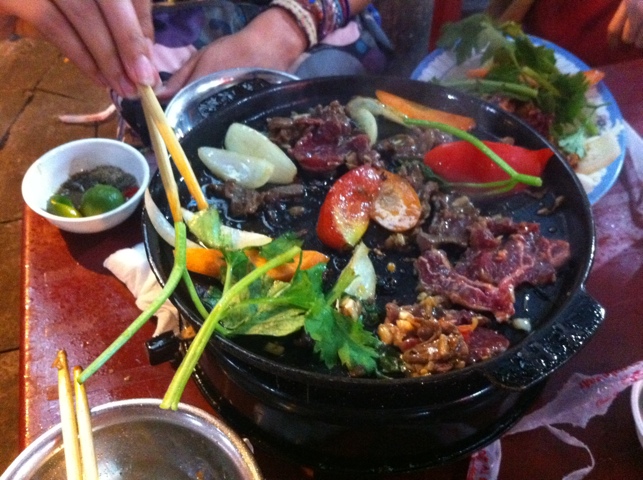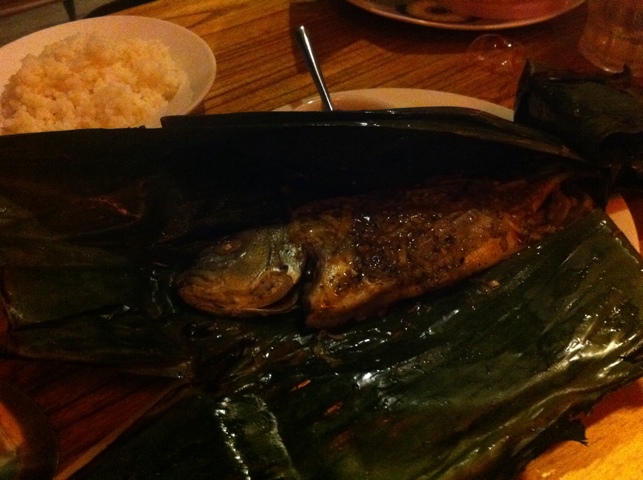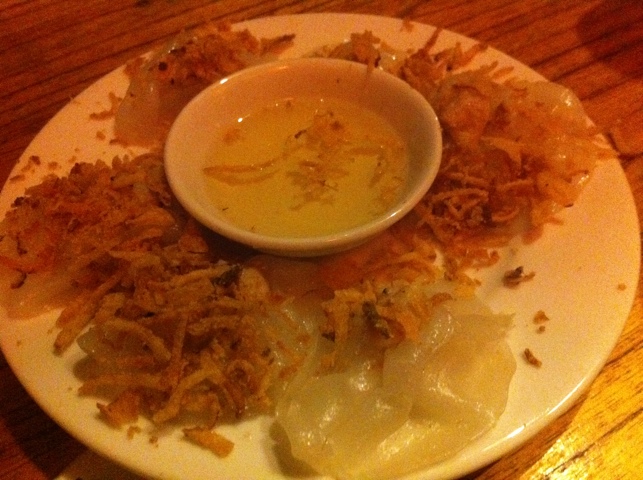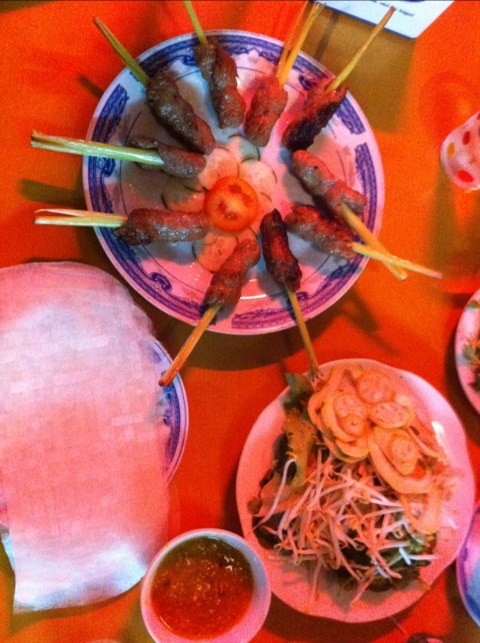A lot of the food in Vietnam is very oriental in style and flavour, probably due to the thousand or so years that the country was occupied by the Chinese. Some aspects of Vietnamese cuisine have reinforced an opinion that we formed in China, namely that one of the benefits of being vegetarian is that you’re far less likely to accidentally find yourself eating some undesirable animal or part thereof, say duck eggs containing nearly mature embryos, or the delights of dog meat. Thankfully, despite not being veggie, we managed to steer clear of these delicacies whilst sampling some of Vietnam’s other specialities…
Pho
One dish that can be found fairly ubiquitously throughout Vietnam is pho. Pho is a noodle soup usually served for breakfast but that can also be found at other mealtimes. Pho consists of a flavoursome broth with rice noodles and chopped spring onions accompanied by either bo (beef), ga (chicken), or lon (pork). The noodle soup is also often supplied (although not always) with some fresh greens (coriander, mint and lettuce) and uncooked bean sprouts bringing a refreshing crunch to the dish. A regional variation in Hue is Bun Bo Hue, a supposedly spicy beef noodle soup. I’m not sure if this dish was simply dulled down for tourists when I tried, but I found it sadly lacking in spice.
Hot pot
I believe that hot pot is probably a Chinese invention, but it is one that has certainly become widespread in Vietnam. A “hot pot” of bubbling spicy broth is placed on the table into which you dunk a variety of meats, seafood, vegetables and noodles, plucking items out when cooked and enjoying the soup at the end. If you want a great hot pot in London, just ask our friend Pey Shan who introduced us to it last year!
Street Food
Street BBQs provide the perfect opportunity to join the locals perching on tiny plastic stools mere inches off the ground, whilst sampling some freshly cooked street food. A plate of beef and vegetables are supplied for you to “barbecue” yourself. However, the term barbecue is used loosely as you are in fact frying the meat in oil on a small gas powered stove. However it’s cooked, the result is very tasty once you’ve braved the spitting oil, darting with your chopsticks to grasp a piece of beef and dabbing it in the seasoning of chinese five spice, salt, pepper, chilli and lime juice.
Fish steamed in banana leaf
This is a fairly simple Vietnamese speciality of delicately seasoned fish encased in a banana leaf and steamed to perfection, presented as a delightful parcel to be unwrapped and shared at the dinner table.
White Rose
This is a delicacy of Hoi An. The white rose, banh bao in Vietnamese, is a small steamed parcel of shrimp or crab meat a in manioc-flour wrapping to be dipped in a lemon and pepper sauce. A delicious little snack or starter!
Spring rolls (nem)
Vietnamese spring rolls come in a number of varieties and are quite different from their Chinese counterpart. Chinese spring rolls are usually made with a wheat-flour casing and are predominantly deep fried, whereas Vietnamese nem are wrapped in rice paper and either eaten fresh, steamed or fried. Fresh spring rolls, sometimes called summer rolls, normally contain glass noodles, raw bean sprouts, and some refreshing green leaves including mint. They can also contain cooked meat such as pork or shrimps (sometimes less pleasantly still encased in their shells) and are wrapped in moistened rice paper. For cooked spring rolls the meat and veg can be rolled in dried rice paper and either eaten as is, steamed, or fried, providing a nice variety of textures and flavours. Another variant tried by Simon was the “roll your own” spring roll, with pork patties molded around lemon grass to be rolled up in rice paper stuffed with salad leaves, rice noodles, carrots and bean sprouts and enjoyed with a sweet and sour chilli sauce.
Baguettes and pastries
The French colonised Vietnam between 1867-1954 and left behind a legacy of baguettes and pastries. You have no idea how wonderful it is to once again taste unsweetened bread!
Rice wine
Rice wine isn’t really a wine, it’s a spirit of around 40% proof made from fermented rice, tasting a lot like rice flavoured vodka.
Coconut juice
Lop the top of a nice green coconut, stick in a straw and voila! You have coconut juice!
Vietnam certainly has some delightful dishes on offer but after the wealth of flavour found in India were sadly a little underwhelming. Whilst I found the food here lacking in spice the same could certainly not be said of garlic which abounds in almost every dish (perhaps this is the reason that Vietnamese cuisine did not endear itself to me)! Hopefully Laos and Cambodia will provoke more of a love for South East Asian cooking.
Laura

